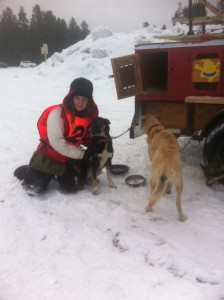I’ve learned a lot through living with dogs. Dog sled mushing is a simple sport. You stand on a sled, and you call out orders. The sport itself is simple. In reality, the trails you’re on decide whether it’s hard or not. Nature itself decides how much of a good time you have, and that is what makes it so exciting.
I’ve heard many people say that the reason they race is for the stories they get to tell. I can’t say that’s not why I race. Every time I go out on that sled I come back with a new story. From camping in a small shack to falling off my sled and having the team take off.
I don’t exactly “live” with eighteen dogs. We have a sponsor that not only funds where we live, but a place for the dogs to stay. He also pays someone to take care of the dogs while we’re away.
That’s one of the only bad things about dog sled mushing. If you dog sled much you never have money. Never. Not once. If you have the proper sponsors (take some top mushers as example) this isn’t a problem.
Don’t get me wrong, I would love to live with the dogs every day. Sadly, an eighteen-dog team in the middle of Ketchum or Hailey doesn’t work out. Even in some of the quieter neighborhoods. While we lived in East Fork we had many people complain about the noise.
Being a dog sled musher comes with risks. Not only risks with where you put the dogs but risks with the races themselves.
This is easily shown at musher meetings. The meeting before each race. It was my first time running longer than 5 miles. The woman told us all about a fence that would be at the bottom of the hill. She said “So there’s gonna be a ninety-degree turn at the bottom of that hill. Directly after that turn there is a fence. You will have to turn your dogs left away from it right after that hill. There will be nobody as we have fewer volunteers this year. Any questions?”
I asked what would happen if we missed that turn. The woman started laughing and then looked at the other mushers.
“You don’t miss that turn.”
Taking care of the dogs can be challenging as well. Feeding dogs twice a day becomes tiring. Especially when you have to train them later on.
Paw injuries are another problem. If a dog gets a paw injury, it can’t run. Paying close attention to their wrists is vital to a successful season.
Dog sled mushing season starts early fall. This varies depending on each type of dog musher. There are mushers who do it for the thrill. Others do it for the competition. Some will start in the winter.
Fall training is used mostly by Iditarod mushers. A cuad (some call it ATV) is used during fall training. I personally find fall training boring. There’s no special control like there is on the sled. There’s the good fun, “Oh, my dogs are going too slow. I’ll just put on some gas.” Or “Oh, it’s getting dark. Let’s turn on the headlights.” What people don’t realise is that it’s more fun when you’re suffering.
There are two main types of mushers. Sprint Mushers and Distance Mushers. Sprint Mushers are usually competitors. This is only in short races though. Although their dogs can run quite fast, their dogs can rarely run long races. (This is usually around 500 miles. It depends on the team though.)
Iditarod mushers like my dad are distance mushers. My dad runs the dogs around 14
miles an hour, but that’s only him. Each musher’s dogs are different with their own personalities.
I’m going to share a quote from a good friend of ours. I know it sounds terrible being a distance musher in thirty-mile races, but “We like to see the trees go by.”
I could go on and on about dog sled mushing. These are only the basics. It may be a lot of work, but the stories I have are worth it. Who else has stories about falling off a dog sled? Or making ninety-degree turns? I love the sport and I plan to continue in the future.
Story by Kali Herbst Minino
